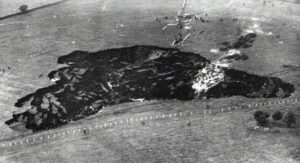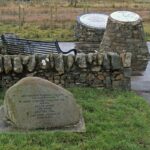 Underground mining always has the potential to become deadly. The people of New Cumnock in Ayrshire, Scotland know that all too well after a mine collapsed, trapped 120 miners underground in Knockshinnoch Castle colliery. The tragic event became known as the Knockshinnoch disaster and it occurred in September 1950 in the village of New Cumnock, Ayrshire, Scotland. The disaster began when a glaciated lake filled with liquid peat and moss flooded the pit workings, trapping more than a hundred miners underground. That set of a rescue effort that lasted for several days. Teams worked non-stop to reach the trapped men. They did finally reach the men, but by the time they were able to reach them, three days later, thirteen men had died.
Underground mining always has the potential to become deadly. The people of New Cumnock in Ayrshire, Scotland know that all too well after a mine collapsed, trapped 120 miners underground in Knockshinnoch Castle colliery. The tragic event became known as the Knockshinnoch disaster and it occurred in September 1950 in the village of New Cumnock, Ayrshire, Scotland. The disaster began when a glaciated lake filled with liquid peat and moss flooded the pit workings, trapping more than a hundred miners underground. That set of a rescue effort that lasted for several days. Teams worked non-stop to reach the trapped men. They did finally reach the men, but by the time they were able to reach them, three days later, thirteen men had died.
The men who survived were all found together 24 hours after the disaster began, and the thirteen men who died had been separated from the main group. They were missing for two more days before they were finally found. When the lake flooded, it released a field about the size of a football field into the mine. The resulting crater was about 300 feet by 200 feet and about 50 feet deep. The crater then sent liquid peat cascading into the mine, effectively blocking any exit for the men.
Thankfully, the mine owners had the forethought to install a phone in the mine, and the miners were able to phone for help. There was no way of reaching them, but the rescuers knew they were still alive, so the rescue efforts began in earnest. Rescue workers decided the easiest way to get them out was through an abandoned mine, next door. It took until 10:30pm local time for the rescuers to clear a passage through the unused mine and break through the final 30-foot wall of coal and rock that separated the two collieries. The rescue team,  made up of hundreds of miners, firefighters, and trained rescuers, worked all day to shore up the walls and ceiling of the old mine. Because the tunnels were so cramped, the workers had to work in shifts, using fans to disperse the gas known as firedamp which accumulates in sealed mines. Firedamp is not poisonous, but it reduces the amount of oxygen in the atmosphere making breathing difficult, not to mention the fact that it is also highly flammable. At one point, a rescue worker collapsed because the air was so foul. He had to be helped to the surface. The situation was really getting serious, and time was running out. The danger of explosion meant the rescuers had to use hand tools to cut through the rock delaying the rescue even more.
made up of hundreds of miners, firefighters, and trained rescuers, worked all day to shore up the walls and ceiling of the old mine. Because the tunnels were so cramped, the workers had to work in shifts, using fans to disperse the gas known as firedamp which accumulates in sealed mines. Firedamp is not poisonous, but it reduces the amount of oxygen in the atmosphere making breathing difficult, not to mention the fact that it is also highly flammable. At one point, a rescue worker collapsed because the air was so foul. He had to be helped to the surface. The situation was really getting serious, and time was running out. The danger of explosion meant the rescuers had to use hand tools to cut through the rock delaying the rescue even more.
Everyone was very focused on saving the trapped men. The volunteers were working above ground, filling the crater made by the landslide with haystacks, trees and other materials to prevent any further slippage. They knew that is more peat fell into the hole, it could have blocked what little ventilation the trapped men had. The buried miners kept in phone contact every 15 minutes or so. They were told how they could help the rescue operation by digging carefully and slowly, so as not to let in a sudden rush of foul air from the unused pit, because they had no oxygen masks to help them breathe.
Finally, the wall was breached. To let the family and friends of the trapped men know that their loved ones were safe, a siren was sounded on the surface. Immediately, huge crowds gathered near the pithead. The police linked arms to form a protective cordon around the exit. The last thing the men needed was a rush of people the minute they reached the surface. Shortly before midnight, rescuers began taking food and drink into the pit for the miners. They had been underground for so long without nutrition and hydration. While the rescuers 
 were now with the men, the process of bringing them out of the mine would not be a speedy one. The rescue tunnel was only wide enough for one man to crawl through at a time, and many are said to be weak, so they waited while they ate and drank some water, before beginning the trek out. The Area Manager of the National Coal Board David McArdle has described the rescue operation as the greatest in the history of Scottish mining.
were now with the men, the process of bringing them out of the mine would not be a speedy one. The rescue tunnel was only wide enough for one man to crawl through at a time, and many are said to be weak, so they waited while they ate and drank some water, before beginning the trek out. The Area Manager of the National Coal Board David McArdle has described the rescue operation as the greatest in the history of Scottish mining.


Leave a Reply